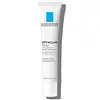What's inside
What's inside
 Key Ingredients
Key Ingredients

 Benefits
Benefits

 Concerns
Concerns

 Ingredients Side-by-side
Ingredients Side-by-side

Water
Skin ConditioningPropylene Glycol Dicaprylate/Dicaprate
EmollientCetearyl Alcohol
EmollientIsohexadecane
EmollientNiacinamide
SmoothingButylene Glycol
HumectantDimethicone
EmollientPolymethyl Methacrylate
Glycerin
HumectantBenzoic Acid
MaskingBHT
AntioxidantButyrospermum Parkii Butter
Skin ConditioningCaprylic/Capric Triglyceride
MaskingCetearyl Glucoside
EmulsifyingDicaprylyl Carbonate
EmollientDisodium EDTA
Disodium Phosphate
BufferingMyrtus Communis Leaf Extract
PerfumingPhenoxyethanol
PreservativePolyacrylate-13
Polyisobutene
Polysorbate 20
EmulsifyingPotassium Phosphate
BufferingSerenoa Serrulata Fruit Extract
Skin ConditioningSodium Cetearyl Sulfate
CleansingSodium Hydroxide
BufferingSorbitan Isostearate
EmulsifyingStearyl Glycyrrhetinate
Skin ConditioningTocopherol
AntioxidantXanthan Gum
EmulsifyingWater, Propylene Glycol Dicaprylate/Dicaprate, Cetearyl Alcohol, Isohexadecane, Niacinamide, Butylene Glycol, Dimethicone, Polymethyl Methacrylate, Glycerin, Benzoic Acid, BHT, Butyrospermum Parkii Butter, Caprylic/Capric Triglyceride, Cetearyl Glucoside, Dicaprylyl Carbonate, Disodium EDTA, Disodium Phosphate, Myrtus Communis Leaf Extract, Phenoxyethanol, Polyacrylate-13, Polyisobutene, Polysorbate 20, Potassium Phosphate, Serenoa Serrulata Fruit Extract, Sodium Cetearyl Sulfate, Sodium Hydroxide, Sorbitan Isostearate, Stearyl Glycyrrhetinate, Tocopherol, Xanthan Gum
Benzoyl Peroxide 5.5%
Water
Skin ConditioningIsostearyl Alcohol
EmollientGlycerin
HumectantPentylene Glycol
Skin ConditioningSilica
AbrasiveCarbomer
Emulsion StabilisingCapryloyl Salicylic Acid
ExfoliatingPotassium Hydroxide
BufferingTocopheryl Acetate
AntioxidantAcrylates/C10-30 Alkyl Acrylate Crosspolymer
Emulsion StabilisingDisodium EDTA
Epilobium Angustifolium Flower/Leaf/Stem Extract
Skin Conditioning
 Reviews
Reviews

Ingredients Explained
These ingredients are found in both products.
Ingredients higher up in an ingredient list are typically present in a larger amount.
Disodium EDTA plays a role in making products more stable by aiding other preservatives.
It is a chelating agent, meaning it neutralizes metal ions that may be found in a product.
Disodium EDTA is a salt of edetic acid and is found to be safe in cosmetic ingredients.
Learn more about Disodium EDTAGlycerin is already naturally found in your skin. It helps moisturize and protect your skin.
A study from 2016 found glycerin to be more effective as a humectant than AHAs and hyaluronic acid.
As a humectant, it helps the skin stay hydrated by pulling moisture to your skin. The low molecular weight of glycerin allows it to pull moisture into the deeper layers of your skin.
Hydrated skin improves your skin barrier; Your skin barrier helps protect against irritants and bacteria.
Glycerin has also been found to have antimicrobial and antiviral properties. Due to these properties, glycerin is often used in wound and burn treatments.
In cosmetics, glycerin is usually derived from plants such as soybean or palm. However, it can also be sourced from animals, such as tallow or animal fat.
This ingredient is organic, colorless, odorless, and non-toxic.
Glycerin is the name for this ingredient in American English. British English uses Glycerol/Glycerine.
Learn more about GlycerinWater. It's the most common cosmetic ingredient of all. You'll usually see it at the top of ingredient lists, meaning that it makes up the largest part of the product.
So why is it so popular? Water most often acts as a solvent - this means that it helps dissolve other ingredients into the formulation.
You'll also recognize water as that liquid we all need to stay alive. If you see this, drink a glass of water. Stay hydrated!
Learn more about Water